Ed Gorman's Blog, page 96
March 28, 2014
Death’s Sweet Song / Whom Gods Destroy by Clifton Adams now from STARK HOUSE
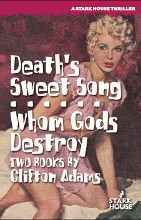
Death’s Sweet Song / Whom Gods Destroy978-1-933586-64-9Clifton Adams is best known for his westerns, but he also wrote two of the best Gold Medal noir thrillers. As August West said of Death’s Sweet Song in the Vintage Hardboiled Reads blog, "This may be the best crime fiction novel that Gold Medal published in the 50s." It’s got it all -— a beautiful, conniving woman, a vulnerable safe, and a guy with lots of moral flexibility. Whom Gods Destroy is the story of a self-destructive bootlegger and the woman he can&apost forgive. Cullen Gallagher of the Los Angeles Review of Books provides a new introduction. Available now.
T
The Desert, The Prairie, and The Gutter: The Noir Novels of Clifton Adamsby Cullen Gallagher
“You were born in the gutter,” she said coldly,“and you’ll live in the gutter all your life!”–Clifton Adams, Whom Gods Destroy
Today, Clifton Adams is primarily remembered as an author of westerns—and for good reason. Twice he won the Western Writers of America’s Spur Award for Best Western Novel, first in 1969 for Tragg’s Choice and then again in 1970 for The Last Days of Wolf Garnett. His prolific body of work consists of titles that immediately evoke their genre, including fifty novels with names such as The Desperado, A Noose for the Desperado, and Lawman.
Westerns may have been Adams’ specialty, but they’re not all that he wrote. In between tales of sheriffs and outlaws, Adams penned five crime novels: WhomGods Destroy and Death’s Sweet Song (both reprinted here), Never Say No To a Killer(as Jonathan Gant), The Long Vendetta(also as Gant) and The Very Wicked(as Nick Hudson). These works stand out not only as some of his best, most harrowing books, but also as examples of some of the edgiest, innovative, and most gut-wrenchingly honest and terrifying crime fiction of their day.
Gold Medal published Adams’ first two noir novels. Whom Gods Destroy, published in 1953, is about Roy Foley, a short order cook in a slummy California diner who is called back to Oklahoma when his father passes away. He’s so broke he can’t even afford to pay for the funeral, but when he hears that the funeral was covered by charity—a charity run by Lola, the girl who laughed in his face back in high school—Roy decides to get revenge by becoming a big man in town, taking over the local bootlegging business, and destroying the reputation of Lola’s politically corrupt husband.
Published two years later in 1955, Death’s Sweet Song is about Joe Hooper, proprietor of a failing motel in the middle of nowhere. When he overhears his guests plotting a robbery, he decides to horn in and take the loot, as well as the girl, for himself.
“But all things end, if you wait long enough,” Adams wrote in Death’s Sweet Song. And, in Whom Gods Destroy, “So this is the way it ends, I thought dully. One jump ahead of the law, two jumps ahead of the chair.” Clifton Adams passed away on October 7, 1971 in San Francisco, CA due to a heart attack. Only fifty-two years old, he left behind a body of work consisting of fifty novels and more than twice that many short stories. Dying so young cut short an extraordinary career still in its prime.
We’ll never know the novels that Adams didn’t get a change to write, and that we didn’t get the chance to read. One thing we do know, however, is that they would have been great. Of that, I am certain.
Published on March 28, 2014 09:57
March 27, 2014
Now Available from Rough Edges Press: Fast Track - Ed Gorman and Bill Crider
Now Available from Rough Edges Press: Fast Track - Ed Gorman and Bill Crider

Dev Mallory has been a Secret Service agent, a detective, and a cowboy...which makes him the perfect man for the job of protecting a British nobleman's Thoroughbred race horse and saving the U.S. government from embarrassment. But there's more going on than sabotage, as Dev's beautiful redheaded partner is kidnapped and Dev finds himself up to his neck in murder, lust, and intrigue.
Critically acclaimed, bestselling authors Ed Gorman and Bill Crider team up for this fast-paced Western mystery now available again from Rough Edges Press. Packed with action and colorful characters, FAST TRACK is an adventure novel where the suspense never lets up!
FAST TRACK on Amazon
FAST TRACK on Barnes & Noble
FAST TRACK on Smashwords
Ed here: I was around halfway through Fast Track when my doc put me in the hospital because of my cancer. Bill took over and did his usual fantastic job. Thanks again, Bill.
Published on March 27, 2014 11:51
March 26, 2014
Scream Queen and Other Tales of Menace Bookgasm Review
Scream Queen and Other Tales of MenaceAuthor: Bruce Grossman[image error] Comments(0)

A new collection of short stories by Ed Gorman is definitely a reason to celebrate. Gorman knows his audience, and the contents in this Perfect Crime collection, SCREAM QUEEN AND OTHER TALES OF MENACE , truly fit the title. The 14 tales range from straight-up crime to peeks into a bizarre future. What will really shock some readers will delight others. Personally what I loved is how in some stories the leads seem so normal until Gorman takes that one little turn and we see the real truth in these characters.
While some might assume where a story goes, like in the opening “Angie,” Gorman throws a change up early on, only to throw another on later. “Angie” deals with a young boy who overhears his career-criminal father, while in the title tale, a video store clerk and his friends figure out one of his customers was a former scream queen, but can’t figure out why she is now living in a small town and keeping her former life a secret. It’s not the sweetest story, which is like saying that gunshot wound isn’t as bad as that other gunshot wound.Two of the OTHER TALES OF MENACE are definite must-reads, but for varying reasons. “Cages” is a near-future work of a young boy who sells something, much to his mother’s disgust, while “Beauty” is officially one of the coldest and most brutal pieces I’ve ever read. All I can say without giving it away is that Gorman is truly one sick bastard, folks. And that’s a compliment.“The Brasher Girl” is an homage to Stephen King; actually Gorman admits in the afterword that it might be considered theft. It deals with two young people and a special well. The well in question holds a secret: an alien living down below who has a control over these two, to the point of killing and other assorted activities. “En Famile” is told from the perspective of a boy who spends his youth with his father at the track and with his first love. “Out There in the Darkness” follows a weekly poker game; a neighborhood watch that goes really, really wrong; and the outcome of the events.Again, some readers might be thrown by some of the brutality in these stories. While longtime crime readers will just clamor for more. With how prolific Gorman is at the short-story format, hopefully we can expect another collection sooner than later. —Bruce Grossman Buy it at Amazon.
Published on March 26, 2014 15:19
March 25, 2014
Evan Hunter interview with Barry Forshaw Crime Time
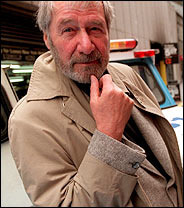 Interviewed by Barry ForshawCrime Time
Interviewed by Barry ForshawCrime TimeHe did it first. You think Hill Street Blues inaugurated the group of detectives scenario, each with his own equally important agenda? No - Ed McBain, aka Evan Hunter, was responsible for this innovation in the remarkable series of 87th Precinct novels, which began with Cop Hater way back in 1956. With very few misfires, McBain has developed this rich, taut and stylish series of books into the locus classicus of the police procedural. Even in this country, The Bill is indebted to McBain's influence. But McBain has also enjoyed success under his own (adopted) name of Evan Hunter, creating the definitive juvenile delinquent novel in The Blackboard Jungle (the film of which memorably started riots to the strains of Bill Haley's Rock Around the Clock). As Hunter, he also produced powerful dramas such as Strangers When We Meet (although the latter tends to read as proto-soap opera these days). His finest hour using the Hunter sobriquet was probably the screenplay for Hitchcock's The Birds (maligned in its day, but now seen as a crucial element in a film finally recognised as one of Hitchcock's late masterpieces).McBain/Hunter was at the House of Lords as the first recipient of the CWA/Cartier Diamond Dagger award. In these august surroundings, he was not inclined to talk about his lifetime's achievement at length, so I cornered him at London's Mysterious Bookshop, where, plied by manageress Sabine Bessler's wine and sandwiches, he proved to be a fascinating interviewee.So... receiving the Cartier award at the House of Lords! How did that feel?Well, they had a guy there with the Queen's Seal, you know? I don't know what his title was, but he had the silver baton with which he'd announce people as they arrived. 'Sir Percival Denham' - just like the movies you saw in the 40s. Standing there with my wife (and Keith Miles and his wife), I have to admit it was quite an experience.And you're the first colonial to receive the award?The first colonial. I once came here to accept an award for Ellery Queen, but that wasn't quite the same. Incidentally, Ellery Queen's son is now my attorney - at least he's the son of one half of Ellery Queen.And you've had a very successful series of novels featuring the attorney Matthew Hope running alongside your 87th Precinct books.Well, The Last Best Hope is, as the title suggests, the last one.The legal profession is held in a kind of contempt that people don't have for cops.You're right, the legal profession IS held in very low esteem. But cops aren't liked either, and, you know the third most despised profession? Dentists. Of course, the image of the cop in the States is, for many, just a step away from the Storm Trooper. And this isn't just LA - Chicago has a similar problem.The new book hasn't got a valedictory feel - why are you pensioning off Matthew?It's difficult to write about a lawyer. You need to do an awful lot of research - I have to check it with two or three attorneys. I have to speak to a practising lawyer and a criminal lawyer.But you presumably had to do similar research for the 87th Precinct books?That became progressively easier, and I often wrapped up the books with a Q & A session with someone from the District Attorney's office. You need to know the procedure about cutting deals and so forth. But with the Hope books, it's always been difficult for me to justify an amateur solving crimes: someone hired by somebody to defend them. He has to be in there, for instance, at the showdown, which is not logical. You'd rarely find a lawyer in that position. In fact, you'd rarely find a police detective in that position.You're widely regarded as the éminence grise behind the police procedural. You could either be said to have inspired the form, or have been ripped off by a lot of people. How do you see it?In some instances I feel flattered, and in others I feel violated. I really don't think Hill Street Blues was an homage to Ed McBain, I think it was a rip off. Without even a tip of the hat - had the creators said somewhere that it was inspired by Ed McBain, I'd feel a little better about it. We are all inspired by what has gone before: none of us sprang out of the earth. But to use the 87th Precinct books as such a clear blueprint is something that goes beyond inspiration.For the rest go here:http://www.crimetime.co.uk/interviews...
Published on March 25, 2014 15:25
March 24, 2014
Five Babes Who Coulda Been Stars! from Classic Films and TV Cafe
Five Babes Who Coulda Been Stars!Timing and looks are almost as important as talent when it comes to becoming a star of the silver screen. Editing room floors have been littered for years with actors that may have had the talent--and definitely had the looks--to earn star status. But alas, their timing was wrong for one reason or another. Today, we pay tribute to five beautiful actresses who never achieved headline status. Some of them had solid careers; others made just a handful of films. And, yes, we will devote a similar post to five handsome hunks later this week.
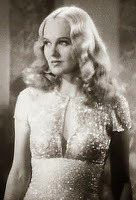 Helen Gilbert. Except for an early lead role opposite Robert Young and Charles Coburn in the horse film Florian, this blonde beauty spent her career in "B" films. She logged appearances in the Andy Hardy, Dr. Kildare, and Falcon series. Her most memorable role was as the femme fatale in
The Falcon Takes Over
, a solid revamped version of Raymond Chandler's Philip Marlowe mystery Farewell, My Lovely. She acted sporadically in the 1940s before moving to television in the 1950s. She was married six times! Johnny Stompanato was one of her husbands--if only for six months. A bodyguard for gangster Mickey Cohen, Stompanato later dated Lana Turner, whose daughter Cheryl Crane stabbed and killed him after she claimed Stompanato had attacked her mother.
Helen Gilbert. Except for an early lead role opposite Robert Young and Charles Coburn in the horse film Florian, this blonde beauty spent her career in "B" films. She logged appearances in the Andy Hardy, Dr. Kildare, and Falcon series. Her most memorable role was as the femme fatale in
The Falcon Takes Over
, a solid revamped version of Raymond Chandler's Philip Marlowe mystery Farewell, My Lovely. She acted sporadically in the 1940s before moving to television in the 1950s. She was married six times! Johnny Stompanato was one of her husbands--if only for six months. A bodyguard for gangster Mickey Cohen, Stompanato later dated Lana Turner, whose daughter Cheryl Crane stabbed and killed him after she claimed Stompanato had attacked her mother.
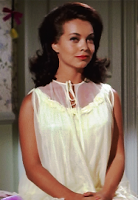 Susan Hart. American International Pictures was grooming this stunning brunette for bigger roles--until she retired from acting a few years after marrying the company's co-founder. Susan Hart appeared in several Beach Party movies as one of "the gang" and played the title character inThe Ghost in the Invisible Bikini. None of these films did much for her career. She fared better as Tab Hunter's love interest in
Ride the Wild Surf
, a Beach Party-like flick released by Columbia Pictures. She also showed her comedy chops as a robot created by mad scientist Vincent Price in the wacky Dr. Goldfoot and the Bikini Machine. In 1964, she married producer James H. Nicholson; she was 24, he was 49. When he died in 1972, she helped complete his films Dirty Mary, Crazy Larry and The Legend of Hell House. Susan Hart spent her later years helping to raise funds for the UCLA Medical Center. She owns the rights to several of her husband's films, which have never been released on video--much to the dismay of many "B" movie fans.
Susan Hart. American International Pictures was grooming this stunning brunette for bigger roles--until she retired from acting a few years after marrying the company's co-founder. Susan Hart appeared in several Beach Party movies as one of "the gang" and played the title character inThe Ghost in the Invisible Bikini. None of these films did much for her career. She fared better as Tab Hunter's love interest in
Ride the Wild Surf
, a Beach Party-like flick released by Columbia Pictures. She also showed her comedy chops as a robot created by mad scientist Vincent Price in the wacky Dr. Goldfoot and the Bikini Machine. In 1964, she married producer James H. Nicholson; she was 24, he was 49. When he died in 1972, she helped complete his films Dirty Mary, Crazy Larry and The Legend of Hell House. Susan Hart spent her later years helping to raise funds for the UCLA Medical Center. She owns the rights to several of her husband's films, which have never been released on video--much to the dismay of many "B" movie fans.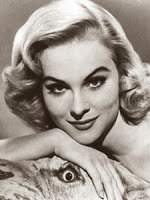 Diane McBain. Signed by Warner Bros. while still a teen, Diane McBain appeared to be on the fast track to stardom in 1960-61. First, she got a plum supporting role in the big-budget Richard Burton-Robert Ryan film Ice Palace. She followed that with a juicy part as a "bad girl" in Parrish and as the "poor white trash" heroine of Claudelle Inglish (both 1961). Concurrently, Warners cast her as a blonde-haired socialite opposite Troy Donahue (hisParrish co-star) in the lighthearted detective TV series Surfside 6. Although the TV series provided steady work, it may also have overexposed her. The once-promising actress soon became typecast as the flighty socialite or bad girl. She worked steadily as a television guest star for the next few decades and in occasional movies--but never appeared in another "A" picture.
Diane McBain. Signed by Warner Bros. while still a teen, Diane McBain appeared to be on the fast track to stardom in 1960-61. First, she got a plum supporting role in the big-budget Richard Burton-Robert Ryan film Ice Palace. She followed that with a juicy part as a "bad girl" in Parrish and as the "poor white trash" heroine of Claudelle Inglish (both 1961). Concurrently, Warners cast her as a blonde-haired socialite opposite Troy Donahue (hisParrish co-star) in the lighthearted detective TV series Surfside 6. Although the TV series provided steady work, it may also have overexposed her. The once-promising actress soon became typecast as the flighty socialite or bad girl. She worked steadily as a television guest star for the next few decades and in occasional movies--but never appeared in another "A" picture.for the rest go here:
http://www.classicfilmtvcafe.com/
Published on March 24, 2014 15:14
March 22, 2014
Daniel Mainwaring from the great site write, write, write
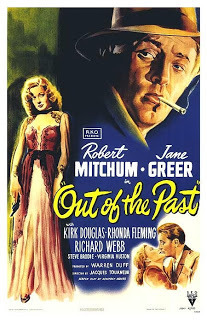
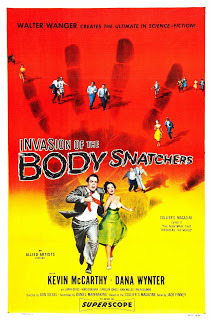
At the age of 32 he published his first crime novel. And churned them out after that - several of them centered around a former reporter turned PI (write what you know and all that, I guess!). He said "In 1935 I got my first job in the industry as a publicity man at Warner Brothers. Working in publicity you got to see and learn more about picture making than the writers did. . . . I didn't escape from the publicity racket until 1943."
He says he started out writing screenplays for Paramount and was happy to forget all of them except for Big Town. After having focused solely on screenplays he took a break to write another novels - it was Build My Gallows High - the blueprint for Out of the Past. Bill Dozier, head of RKO read it, bought it and Daniel Mainwaring with it. One thing that apparently clinched the deal was the gimmick scene in the novel where the mute boy uses his fishing rod to cast a hook and pull the bad guy to his death - the producers loved that scene and could just picture it.
Out of the Past, directed by Jacques Tourneur, starred Robert Mitchum, Kirk Douglas, Jane Greer and Rhonda Fleming. Initially, Mainwaring had actually personally taken the script to Humphrey Bogart. According to Mainwaring, Bogie wanted to do it, but Warner Brothers wouldn't let him. Possible that Warner Brothers was still pissed off because in 1945 they had bid for the not-yet-published Build The Gallows High, too - and lost to RKO. So, with Bogie out, RKO then considered
In an interview, Daniel Mainwaring was asked about other writers involved in the adaptation of Out of the Past: "I wrote the first draft, and Duff (producer Warren Duff) wasn't sure about it. All I had done were those pictures for Pine and Thomas (for Paramount). When I finished and went on to something else, Duff put
In his take on Out of the Past, Roger Ebert has a bit more information. He refers to critic Jeff Schwager who read all the various drafts. Schwager agreed that the Cain was bad, but that Mainwaring's first draft wasn't that good either. He says that the great dialogue actually came from Frank Fenton. Well, be that as it may - movie making is collaborating!
Now about Invasion of the Body Snatchers. Mainwaring had met Don Siegel way back when he was still working as a publicist. At that point Siegel had been an aspiring director. Something you see again and again - a writer's career often grows as the network's career grows. Focus on people at your career stage - work with them and grow with them. It certainly worked for Daniel Mainwaring. He worked with Siegel on The Big Steal in 1949 (it was basically RKO trying to capitalize on the success of Out of the Past - same stars, same writer). Mainwaring and Siegel collaborated four more times and their biggest success was of course Invasion of the Body Snatchers.
for the whole piece go here:
http://www.danielmartineckhart.com/20...
Published on March 22, 2014 12:27
Dead Resurrection by John McCarty
Hi Folks:
Pardon this mass mailing, but the publisher roped me into it.
Just when you thought it was safe to go back into the bookstore, Crossroad Press has resurrected my first (and to date only) published novel, Deadly Resurrection (1990), as an e-book. If you know anyone looking for some relentless suspense, please forward this message. It�s available directly from the publisher (www.crossroadpress.com) in the following e-formats: Mobi (Kindle); ePub (Sony / Nook / iPad / Kobo); PDF (Adobe) PRC (Mobipocket); and at most other online e-book sellers, including Amazon.com and barnesandnoble.com. Check it out!
Thanks.John Mc
Ed here: A well written page turner by a fine fine writer.
[image error]
Pardon this mass mailing, but the publisher roped me into it.
Just when you thought it was safe to go back into the bookstore, Crossroad Press has resurrected my first (and to date only) published novel, Deadly Resurrection (1990), as an e-book. If you know anyone looking for some relentless suspense, please forward this message. It�s available directly from the publisher (www.crossroadpress.com) in the following e-formats: Mobi (Kindle); ePub (Sony / Nook / iPad / Kobo); PDF (Adobe) PRC (Mobipocket); and at most other online e-book sellers, including Amazon.com and barnesandnoble.com. Check it out!
Thanks.John Mc
Ed here: A well written page turner by a fine fine writer.
[image error]
Published on March 22, 2014 08:33
March 21, 2014
W.R. Burnett interview
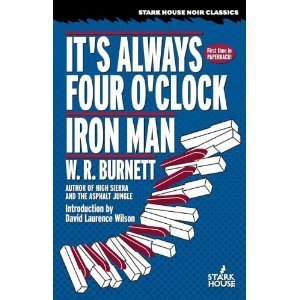
Ed here: This is a note in front of this great two-fer which you need to read. One thing to keep in mind about Burnett; a few of his westerns are as hardboiled and noirish as his crime novels.
In 1981, our own David Laurence Wilson interviewed Burnett upon the publication of Goodbye, Chicago. He's agreed to let us publish much of that interview here,
DLW: After Little Caesar you left Chicago.WRB: Yes. Money was falling out of my ears and my first wife and I came to California as tourists. I had absolutely no desire to write for pictures but people kept calling me from the studios. I thought they were crazy and I told them so. Then I got a call from Graham Baker, the story editor at Warner Brothers. He told me they were making a picture that might interest me and I told him I wasn’t interested. Then he and John Monk Saunders, who wrote WINGS, was writing “The Finger Points,” a story about Chicago gangsters. Could I just come in and talk, to sit in as an adviser? He asked me how much I’d want to do that. I didn’t care if I got the job or not so I thought of the highest thing I could imagine, a thousand a week. Baker said, “Go to work Monday!” I called my father in Chicago, told him what I was getting and he said, “You’re a liar! Nobody gets a thousand a week!” So I sent him a copy of the first check. Later Baker told me I’d been a sucker. He would have paid me twenty-five hundred.DLW: So you talked.WRB: For a thousand a week, we talked about everything. One week passed, then a second. Saunders spoke about Hemingway — he knew him. After three weeks we got a call from the front office. They wanted us to come in that afternoon, to tell them what we’d done. I thought the gig was up but Saunders told me not to worry. He told me to sit and nod my head, to agree with him no matter what he said. I was scared, but then, when we got there, he ad libbed the entire story. They sat there and said, “Wow! You guys are doing fine!” But as far as I was concerned, we hadn’t done a goddamn thing.DLW: So did he write the story after the conference?WRB: Well, no, I did the writing. I had to do it. That’s the climax of the story. It wasn’t the same story he had told them but it had some of the same elements. But after all, it was my first screenplay, and writing it, it wasn’t too good.DLW: After that you did SCARFACE, for Howard Hughes?WRB: Yes. United Artists called me so I went in to talk to Hughes and even then, when he was a kid, he was deaf in one ear, so to speak with him, you had to stand at his side. He was in all kinds of trouble so he said, “Will you see what you can do? Whatever you can do, I’d appreciate it.” So now I was getting twenty-five hundred a week.DLW: Were you the first writer on the picture?WRB: Oh no! I went up to my office and that afternoon they started bringing in the scripts. They had about fifteen of them. Well, of course, I was new and to be frank, I didn’t know what the hell I was doing. I began to read the scripts and oh, they were terrible. I sort of put together a bunch of scenes which I thought were pertinent and rewrote it.DLW: What about those fifteen scripts? Were they all the same story?WRB: Oh no, they were all screwed up. It was made from a pulp book, you know, and it was awful — junk, but Hughes had paid twenty-five thousand dollars for it. Hughes liked what I did and when I left, I thought they had a pretty good script. Finally they called in Ben Hecht. Ben read it and told them he’d get it ready for a thousand a day, and that’s what he did. It became a very successful picture.DLW: Then you stayed in Hollywood, writing scripts.WRB: Yes, but I never stopped writing the books. I never went seriously into writing for pictures until nineteen thirty-eight, when I went broke. In spite of all the money I made, with practically no taxes, I went broke gambling, horses and dogs. I owned eighty dogs, at one time, on a farm, and racing. On top of that I was betting on horses. For a while I was making more money racing dogs than I was writing, because I had the National Champion race dog, and they’d pay me fifteen hundred dollars a week just to bring him to a track. Then he’d race against time. But they they knocked greyhound racing out of California and I had to ship to Boston and Florida. Pretty soon it became too expensive. So I went broke. I owed everybody. Then I wrote High Sierra. I had another big seller, I sold it to Warner Brothers for a good price, and that got me started all over again. Fine timing. Just right. I’m lucky, I tell you, I’m a lucky bastard! I quit the races, however. One day I was at Santa Anita, I won two races but both times the horses were disqualified. I never went back after that.DLW: You haven’t had a new book out in the U.S. for twelve years.WRB: The last one was The Cool Man, in ‘68. After several incidents I said, the hell with it so I kept writing and I just put them away. I sent two books to New York in eleven years. Fortunately, I can live without them. They’re all sorts of novels, and most of them aren’t even copies. There’s one that I love that everybody else hates. It’s called The Limelight, about a famous Hollywood actor who goes downhill and ends up owning a supper club in the Midwest. He’s deserted his family and his son is searching for him. My trouble, you see, is that I’m basically a comic writer. It’s something I’ve always had to restrain. I see the world through a funny angle.
Published on March 21, 2014 13:33
March 20, 2014
Forgotten Books: EPITAPHS by Bill Pronzini
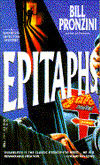
Epitaphs is one of my favorite Nameless novels for a number of reasons.
For one thing this is one of Pronzini's finest depictions of Nameless' painfully complex relationship with his old partner Eberhardt. The anger, the distrust makes you feel sorry for both of them.
Then there's the even more serious problem of his friend and lover Kerry not wanting to marry him.
The novel is also a fine depiction of how Nameless' North Beach is changing and is being refurbished not only commercially but also sociologically. Proninzi writes with real power about how the Italian heritage he obviously reveres is also suffering because of the changes.
Then there's the story and it's one of Pronzini's most skillfully conceived and maneuvered. Gianna Fornessi is the name of the beautiful granddaughter who is missing. A mutual friend of Namless' asks him to help the grandfather who fears for her.
When he finds where she lives Nameless also realizes that something is wrong. She came from a humble area of North Beach but lives in a style fitting a much more moneyed life.
From this hook Pronzini takes us through enough ruses, masques, dead ends and mysterious but enigmatic clues to fill three or four average novels. And he does so with prose so evocative of both place and passion that you race to the end.
One of Bill Pronzini's finest novels and I don't have to say much more than that, do I?
Published on March 20, 2014 13:03
March 19, 2014
Mongo’s Back in Town
Posted by R. Emmet Sweeney on March 18, 2014 Movie Morlocks
Mongo’s Back in Town was adapted from a novel by E. Richard Johnson, a convicted murderer and armed robber who spent most of his life in Minnesota State Prison. He won the 1968 Edgar Award from the Mystery Writers of America for his debut novel Silver Street, and Mongo was his equally well-received follow up. He wrote seven books in four years of imprisonment before escaping, succumbing to drug addiction, and getting recaptured. The terse teleplay by Herman Miller (Coogan’s Bluff) feels very faithful to Johnson’s book in its bleak and withholding nature. The basic story is straightforward but willfully opaque in its details. Mongo is called home by his estranged brother Mike (Charles Cioffi) to knock off one of his rivals. The reasons are murky, cloaked in brief, diversionary bits of dialogue. The film reveals its intentions with its opening sequence, six minutes of wordless action that introduces the characters. Joe Don Baker arrives in town with nothing, not even an overcoat to protect him from the sheets of rain. He smashes the cheap knick knacks being sold by a blind peddler. The camera then follows the peddler, who enters a rundown strip club. As the floor is scrubbed by a little person in the extreme foreground, the peddler whispers a message to Mike that we cannot hear. Mike then climbs the staircase into his upstairs apartment. Upon opening the door to his bedroom, a deck of cards set up like dominos tumble down in a line to his wife Angel’s (Anne Francis) feet. It’s a willfully strange sequence, one portraying the city as a network of criminality laid down at the feet of Angel. Whether this sequence was orchestrated by director Marvin J. Chomsky, DP Archie R. Dalzell or producer Bob Banner, it’s an effectively disorienting way to set up the knotty plot to come.
Joe Don Baker arrives in town with nothing, not even an overcoat to protect him from the sheets of rain. He smashes the cheap knick knacks being sold by a blind peddler. The camera then follows the peddler, who enters a rundown strip club. As the floor is scrubbed by a little person in the extreme foreground, the peddler whispers a message to Mike that we cannot hear. Mike then climbs the staircase into his upstairs apartment. Upon opening the door to his bedroom, a deck of cards set up like dominos tumble down in a line to his wife Angel’s (Anne Francis) feet. It’s a willfully strange sequence, one portraying the city as a network of criminality laid down at the feet of Angel. Whether this sequence was orchestrated by director Marvin J. Chomsky, DP Archie R. Dalzell or producer Bob Banner, it’s an effectively disorienting way to set up the knotty plot to come.
 The countervailing forces are the investigating detectives, played with exhausted Kojakery by Telly Savalas and a callow Martin Sheen (sporting the same pompadour as in Badlands (’73). Lieutenant Tolstad (Savalas) is burnt out from working this scummy precinct, represented in exteriors of dive bars, peep shows and strip clubs. He seems as nihilistic as Mongo, who flicks lit matches at his brother and picks up runaway coal miner’s daughter Vikki (Sally Field) at a diner, only to cruelly play with her emotions. In the triangulated climax, Vikki is torn between these two used up men, her face tensed up, staring at the phone booth that could call Tolstad, and at the club doors that Mongo is about to bust out of. In the end, like all of the characters in this strange, bitter little film, she chooses apathy. Fate decides for her, as it did for E. Richard Johnson.
The countervailing forces are the investigating detectives, played with exhausted Kojakery by Telly Savalas and a callow Martin Sheen (sporting the same pompadour as in Badlands (’73). Lieutenant Tolstad (Savalas) is burnt out from working this scummy precinct, represented in exteriors of dive bars, peep shows and strip clubs. He seems as nihilistic as Mongo, who flicks lit matches at his brother and picks up runaway coal miner’s daughter Vikki (Sally Field) at a diner, only to cruelly play with her emotions. In the triangulated climax, Vikki is torn between these two used up men, her face tensed up, staring at the phone booth that could call Tolstad, and at the club doors that Mongo is about to bust out of. In the end, like all of the characters in this strange, bitter little film, she chooses apathy. Fate decides for her, as it did for E. Richard Johnson.
Mongo’s Back in Town was adapted from a novel by E. Richard Johnson, a convicted murderer and armed robber who spent most of his life in Minnesota State Prison. He won the 1968 Edgar Award from the Mystery Writers of America for his debut novel Silver Street, and Mongo was his equally well-received follow up. He wrote seven books in four years of imprisonment before escaping, succumbing to drug addiction, and getting recaptured. The terse teleplay by Herman Miller (Coogan’s Bluff) feels very faithful to Johnson’s book in its bleak and withholding nature. The basic story is straightforward but willfully opaque in its details. Mongo is called home by his estranged brother Mike (Charles Cioffi) to knock off one of his rivals. The reasons are murky, cloaked in brief, diversionary bits of dialogue. The film reveals its intentions with its opening sequence, six minutes of wordless action that introduces the characters.
 Joe Don Baker arrives in town with nothing, not even an overcoat to protect him from the sheets of rain. He smashes the cheap knick knacks being sold by a blind peddler. The camera then follows the peddler, who enters a rundown strip club. As the floor is scrubbed by a little person in the extreme foreground, the peddler whispers a message to Mike that we cannot hear. Mike then climbs the staircase into his upstairs apartment. Upon opening the door to his bedroom, a deck of cards set up like dominos tumble down in a line to his wife Angel’s (Anne Francis) feet. It’s a willfully strange sequence, one portraying the city as a network of criminality laid down at the feet of Angel. Whether this sequence was orchestrated by director Marvin J. Chomsky, DP Archie R. Dalzell or producer Bob Banner, it’s an effectively disorienting way to set up the knotty plot to come.
Joe Don Baker arrives in town with nothing, not even an overcoat to protect him from the sheets of rain. He smashes the cheap knick knacks being sold by a blind peddler. The camera then follows the peddler, who enters a rundown strip club. As the floor is scrubbed by a little person in the extreme foreground, the peddler whispers a message to Mike that we cannot hear. Mike then climbs the staircase into his upstairs apartment. Upon opening the door to his bedroom, a deck of cards set up like dominos tumble down in a line to his wife Angel’s (Anne Francis) feet. It’s a willfully strange sequence, one portraying the city as a network of criminality laid down at the feet of Angel. Whether this sequence was orchestrated by director Marvin J. Chomsky, DP Archie R. Dalzell or producer Bob Banner, it’s an effectively disorienting way to set up the knotty plot to come.
 The countervailing forces are the investigating detectives, played with exhausted Kojakery by Telly Savalas and a callow Martin Sheen (sporting the same pompadour as in Badlands (’73). Lieutenant Tolstad (Savalas) is burnt out from working this scummy precinct, represented in exteriors of dive bars, peep shows and strip clubs. He seems as nihilistic as Mongo, who flicks lit matches at his brother and picks up runaway coal miner’s daughter Vikki (Sally Field) at a diner, only to cruelly play with her emotions. In the triangulated climax, Vikki is torn between these two used up men, her face tensed up, staring at the phone booth that could call Tolstad, and at the club doors that Mongo is about to bust out of. In the end, like all of the characters in this strange, bitter little film, she chooses apathy. Fate decides for her, as it did for E. Richard Johnson.
The countervailing forces are the investigating detectives, played with exhausted Kojakery by Telly Savalas and a callow Martin Sheen (sporting the same pompadour as in Badlands (’73). Lieutenant Tolstad (Savalas) is burnt out from working this scummy precinct, represented in exteriors of dive bars, peep shows and strip clubs. He seems as nihilistic as Mongo, who flicks lit matches at his brother and picks up runaway coal miner’s daughter Vikki (Sally Field) at a diner, only to cruelly play with her emotions. In the triangulated climax, Vikki is torn between these two used up men, her face tensed up, staring at the phone booth that could call Tolstad, and at the club doors that Mongo is about to bust out of. In the end, like all of the characters in this strange, bitter little film, she chooses apathy. Fate decides for her, as it did for E. Richard Johnson.
Published on March 19, 2014 14:05
Ed Gorman's Blog
- Ed Gorman's profile
- 118 followers
Ed Gorman isn't a Goodreads Author
(yet),
but they
do have a blog,
so here are some recent posts imported from
their feed.



